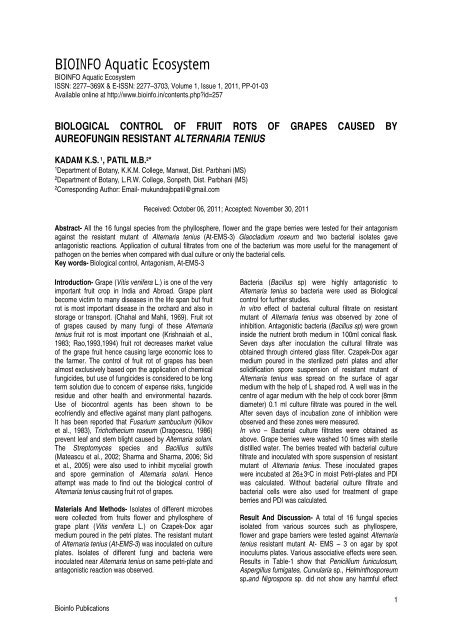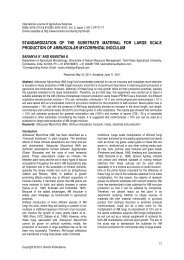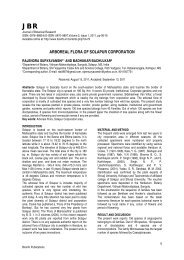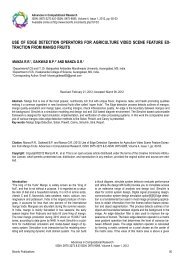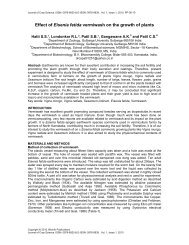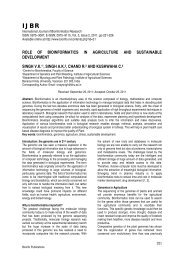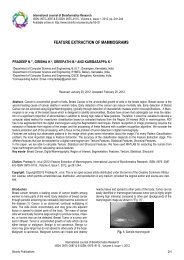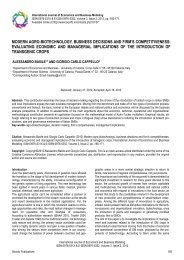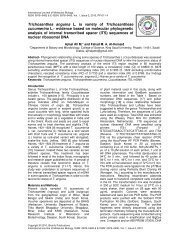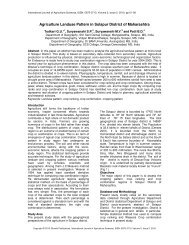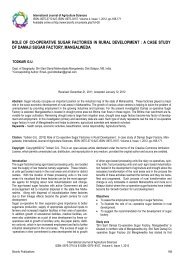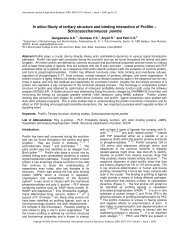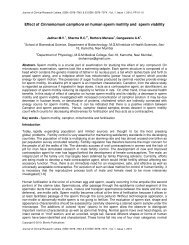BIOINFO Aquatic Ecosystem - Bioinfo Publications
BIOINFO Aquatic Ecosystem - Bioinfo Publications
BIOINFO Aquatic Ecosystem - Bioinfo Publications
Create successful ePaper yourself
Turn your PDF publications into a flip-book with our unique Google optimized e-Paper software.
<strong>BIOINFO</strong> <strong>Aquatic</strong> <strong>Ecosystem</strong><br />
<strong>BIOINFO</strong> <strong>Aquatic</strong> <strong>Ecosystem</strong><br />
ISSN: 2277–369X & E-ISSN: 2277–3703, Volume 1, Issue 1, 2011, PP-01-03<br />
Available online at http://www.bioinfo.in/contents.php?id=257<br />
BIOLOGICAL CONTROL OF FRUIT ROTS OF GRAPES CAUSED BY<br />
AUREOFUNGIN RESISTANT ALTERNARIA TENIUS<br />
KADAM K.S. 1 , PATIL M.B. 2 *<br />
1 Department of Botany, K.K.M. College, Manwat, Dist. Parbhani (MS)<br />
2 Department of Botany, L.R.W. College, Sonpeth, Dist. Parbhani (MS)<br />
2 Corresponding Author: Email- mukundrajbpatil@gmail.com<br />
<strong>Bioinfo</strong> <strong>Publications</strong><br />
Received: October 06, 2011; Accepted: November 30, 2011<br />
Abstract- All the 16 fungal species from the phyllosphere, flower and the grape berries were tested for their antagonism<br />
against the resistant mutant of Alternaria tenius (At-EMS-3) Glaocladium roseum and two bacterial isolates gave<br />
antagonistic reactions. Application of cultural filtrates from one of the bacterium was more useful for the management of<br />
pathogen on the berries when compared with dual culture or only the bacterial cells.<br />
Key words- Biological control, Antagonism, At-EMS-3<br />
Introduction- Grape (Vitis venifera L.) is one of the very<br />
important fruit crop in India and Abroad. Grape plant<br />
become victim to many diseases in the life span but fruit<br />
rot is most important disease in the orchard and also in<br />
storage or transport. (Chahal and Mahli, 1969). Fruit rot<br />
of grapes caused by many fungi of these Alternaria<br />
tenius fruit rot is most important one (Krishnaiah et al.,<br />
1983; Rao,1993,1994) fruit rot decreases market value<br />
of the grape fruit hence causing large economic loss to<br />
the farmer. The control of fruit rot of grapes has been<br />
almost exclusively based opn the application of chemical<br />
fungicides, but use of fungicides is considered to be long<br />
term solution due to concern of expense risks, fungicide<br />
residue and other health and environmental hazards.<br />
Use of biocontrol agents has been shown to be<br />
ecofriendly and effective against many plant pathogens.<br />
It has been reported that Fusarium sambucilum (Kilkov<br />
et al., 1983), Trichothecium roseum (Dragoescu, 1986)<br />
prevent leaf and stem blight caused by Alternaria solani.<br />
The Streptomyces species and Bacillius sultilis<br />
(Mateascu et al., 2002; Sharma and Sharma, 2006; Sid<br />
et al., 2005) were also used to inhibit mycelial growth<br />
and spore germination of Alternaria solani. Hence<br />
attempt was made to find out the biological control of<br />
Alternaria tenius causing fruit rot of grapes.<br />
Materials And Methods- Isolates of different microbes<br />
were collected from fruits flower and phyllosphere of<br />
grape plant (Vitis venifera L.) on Czapek-Dox agar<br />
medium poured in the petri plates. The resistant mutant<br />
of Alternaria tenius (At-EMS-3) was inoculated on culture<br />
plates. Isolates of different fungi and bacteria were<br />
inoculated near Alternaria tenius on same petri-plate and<br />
antagonistic reaction was observed.<br />
Bacteria (Bacillus sp) were highly antagonistic to<br />
Alternaria tenius so bacteria were used as Biological<br />
control for further studies.<br />
In vitro effect of bacterial cultural filtrate on resistant<br />
mutant of Alternaria tenius was observed by zone of<br />
inhibition. Antagonistic bacteria (Bacillus sp) were grown<br />
inside the nutrient broth medium in 100ml conical flask.<br />
Seven days after inoculation the cultural filtrate was<br />
obtained through cintered glass filter. Czapek-Dox agar<br />
medium poured in the sterilized petri plates and after<br />
solidification spore suspension of resistant mutant of<br />
Alternaria tenius was spread on the surface of agar<br />
medium with the help of L shaped rod. A well was in the<br />
centre of agar medium with the help of cock borer (8mm<br />
diameter) 0.1 ml culture filtrate was poured in the well.<br />
After seven days of incubation zone of inhibition were<br />
observed and these zones were measured.<br />
In vivo – Bacterial culture filtrates were obtained as<br />
above. Grape berries were washed 10 times with sterile<br />
distilled water. The berries treated with bacterial culture<br />
filtrate and inoculated with spore suspension of resistant<br />
mutant of Alternaria tenius. These inoculated grapes<br />
were incubated at 26±3 oC in moist Petri-plates and PDI<br />
was calculated. Without bacterial culture filtrate and<br />
bacterial cells were also used for treatment of grape<br />
berries and PDI was calculated.<br />
Result And Discussion- A total of 16 fungal species<br />
isolated from various sources such as phyllospere,<br />
flower and grape barriers were tested against Alternaria<br />
tenius resistant mutant At- EMS – 3 on agar by spot<br />
inoculums plates. Various associative effects were seen.<br />
Results in Table-1 show that Penicillium funiculosum,<br />
Aspergillus fumigates, Curvularia sp., Helminthosporeum<br />
sp.and Nigrospora sp. did not show any harmful effect<br />
1
Biological control of fruit rots of grapes caused by aureofungin resistant Alternaria tenius<br />
against each other. Alternaria tenius mutant overlapped<br />
on Penicillium varians, Aspergillus flavus, Aspergillus<br />
niger Chaetomium sp. and Cunnighamella sp. On the<br />
other hand Rhizopus sp., Cladosporium sp.,<br />
Trichoderma sp. Overlapped on Alternaria tenius mutant.<br />
Gliocladium roseum and two bacterial isolates indicated<br />
antagonistic zone towards Alternaria tenius (Plate I). One<br />
of the bacterial isolates was used for biological control of<br />
A. tenius mutants on agar plate and also on grape<br />
berries.<br />
Effects of bacterial culture filtrate on resistant mutant of<br />
A. tenius was observed by zone inhibition. Result in<br />
Table-2 and Plate II showed that inhibitory zone of<br />
bacterial culture filtrate was useful for the management<br />
of pathogen. The inhibitory zone of the two bacterial<br />
culture filtrates used were ranged from 11.5 to 13.5.<br />
Results in Table-3 showed that application of culture<br />
filtrate was more useful for management of this pathogen<br />
on the berries when compared with the dual culture<br />
and/or with the bacterial cells.<br />
References<br />
[1] Chahal, D.C. and C.S. Malhi (1969). Fungi<br />
associated with rotting of stored grapes in the<br />
norh western India. Indian J. Hort. 26(1 & 2):<br />
186-192.<br />
[2] Dragoesch, E (1986). Effect of some<br />
fungicides on the interrelation between<br />
Alternaria porri f. sp. Solani and Trchothecium<br />
roseum isolated from potato. Analele<br />
institutului de cercetari pentru protectia<br />
plantelor , 19: 195-199.<br />
<strong>BIOINFO</strong> <strong>Aquatic</strong> <strong>Ecosystem</strong><br />
ISSN: 2277–369X & E-ISSN: 2277–3703, Volume 1, Issue 1, 2011<br />
[3] Kilkov, S.A., Volovik, A.S., Cholova, L.I.,<br />
Ozeretskov-kauskaya, V.L. (1903). Induction<br />
of disease resistance in potato dry with<br />
mycelium extracts from the pathogen of the<br />
disease. Mikologiya at Fitopathologia, 17: 334-<br />
340.<br />
[4] Krishnaih, Satyaprakash, Giridharsing,<br />
Shankerlingan, Thirupathak (1983). Control of<br />
Alternaria rot of grape by using wax. Sci. and<br />
cult. 49 (12): 391-393.<br />
[5] Mateascu R., Cornea P.C., Grebenisan, I,<br />
Babeanu, N., Campeanu, G. (2002) In vitro<br />
biocontrol activity of Bacillus spp. on Alternaria<br />
tenius. Faculty of biotechnology, UASVM<br />
Bucharest, 59 Bd. Marasti, Romania.<br />
[6] Rao, V. G. (1993). Fungal diseases of grape<br />
and their control. Drakshavritta Souvenir<br />
6:137-138.<br />
[7] Rao, V. G. (1994). Alternaria disease of grape.<br />
Drakshavritta Sovenir. 6: 137-138.<br />
[8] Sharma N., Sharma S. (2006). Control of foliar<br />
diseases of mustard by Bacillus from reclaimed<br />
soil. Microbial. Res., 163 (4):569-574. E.<br />
public. July. 2008.<br />
[9] Sid, A., Eziyyani, M., Egea- Gilabert, C.,<br />
Candela, M.E. (2005). Selecting bacterial<br />
strains for use in the biocontrol of diseases<br />
caused by Phytophthora capsici and Alternaria<br />
alternata in sweet pepper plants. Biologia<br />
Plantarum, 47 (4):569-574.<br />
Table 1: Antagonistic and associate relationship between Alternaria tenius and other phyllosphere, flower and berries fungi<br />
of grapes.<br />
Sr no. Name of the fungi Reaction A Reaction B Reaction C Reaction D<br />
1. Penicillium funiculosum + - - -<br />
2. Penicillium varians - + - -<br />
3. Aspergillus flavus - + - -<br />
4. Aspergillus niger - + - -<br />
5. Aspergillus fumigates + - - -<br />
6. Curvularia sp. + - - -<br />
7. Heminthosporium sp. + - - -<br />
8. Nigrospora sp. + - - -<br />
9. Chaetomium sp. - + - -<br />
10. Cunninghamella sp. - + - -<br />
11. Cladosporium sp. - - + -<br />
12. Rhizopus sp. - - + -<br />
13. Trichoderma sp. - - + -<br />
14. Gliocladium roseum sp. - - - + (2)<br />
15. Bacillus sp. - - - + (3)<br />
16. Bacillus Sp. - - - + (3)<br />
A = Both colonies grow side by side without harming each other<br />
B = Alternaria tenius overlaps on other fungi.<br />
C = Other fungi overlaps on Alternaria tenius.<br />
D = Other fungi antagonistic to Alternaria tenius.<br />
*Figures in parentyhesis show antagonistic zone in mm.<br />
2
<strong>Bioinfo</strong> <strong>Publications</strong><br />
Kadam KS, Patil MB<br />
Table 2-Inhibitory action of bacterial culture filtrate against Alternaria tenius (At- EMS-3) by cup plate method.<br />
Sr.No. Bacterial culture filtrate Inhibitory zone(mm)<br />
1. Bacillus spp. 11.5<br />
2. Bacillus spp. 13.5<br />
Table 3- Percentage control efficacy (PCE), Bacillus sp. Culture filtrate against Aureofungin resistant mutant of<br />
Alternaria tenius on grape berries.<br />
Bacterial sources PCE<br />
Culture filtrate 84.21<br />
Dual culture 71.10<br />
Bacterial cells 59.89<br />
S.E. 5.73<br />
C.D. at 0.05 81.14<br />
C.D. at 0.01 85.04<br />
Plate- I- Bacterium antagonistic to A. tenius (At- EMS – 3)<br />
Plate- II- Inhibition zone of Bacterial culture filtrates to antagonistic to A. tenius (At- EMS – 3) on Agar plates<br />
3


